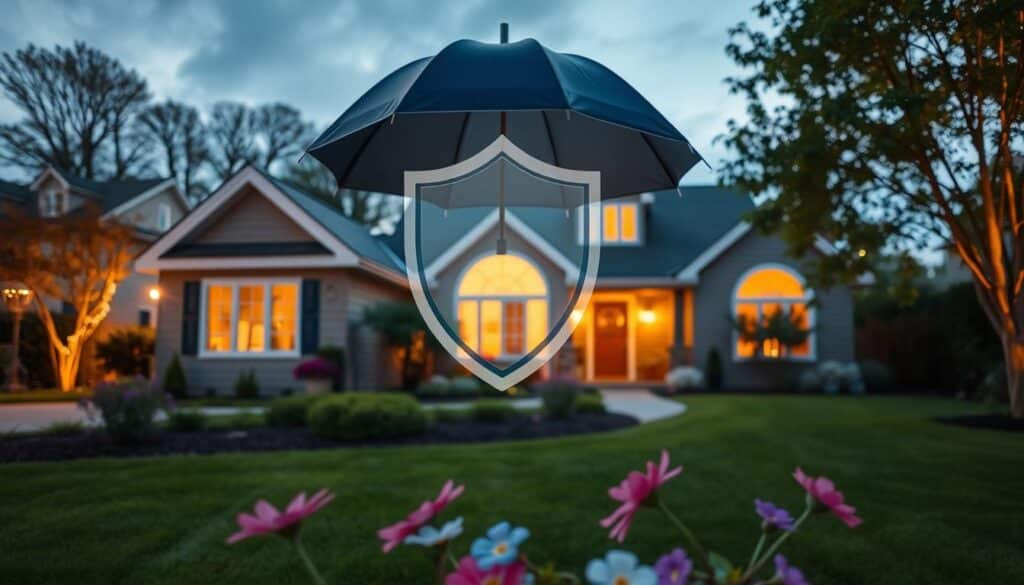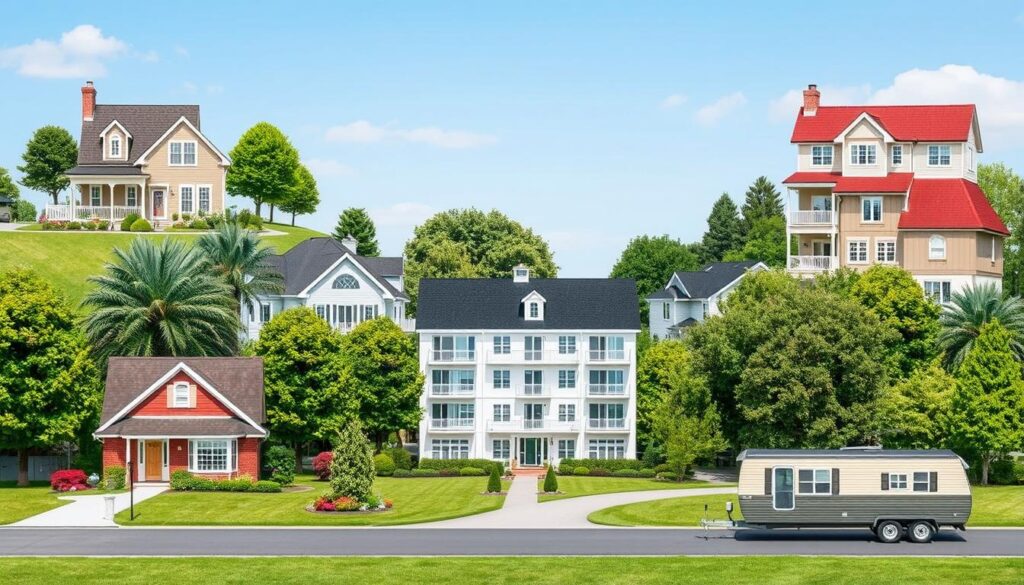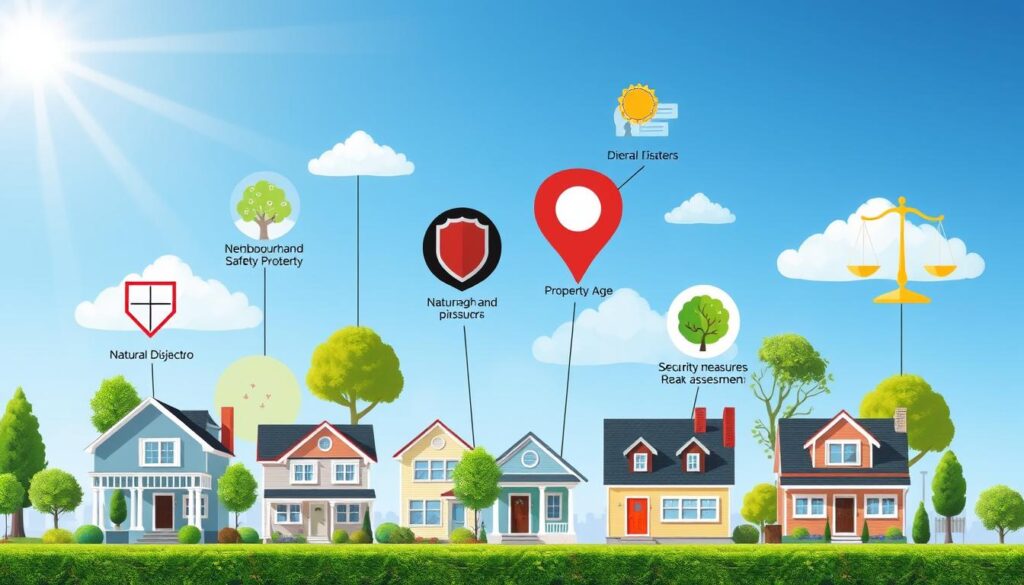Are you sure your home and stuff are safe? Home insurance, or homeowner’s insurance, is key to protecting your most valuable things. It’s important for both new and experienced homeowners to know about home insurance. This guide will help you make smart choices and keep your home and money safe.

Key Takeaways
- Home insurance policies usually cover damage, loss, and liability for homeowners.
- There are three main coverage levels: actual cash value, replacement cost, and extended replacement cost/value.
- Insurers look at claim history, neighborhood, and home condition to set policy rates.
- Homeowners insurance is crucial to meet mortgage lender needs and protect personal assets.
- Coverage includes the dwelling, other structures, personal property, liability, and medical payments.
What is Home Insurance?
Home insurance, also known as homeowners insurance, protects your home and belongings. It covers damages or liabilities. By paying a premium, you get coverage for your home, personal items, and more.
Key Terms to Understand
There are important terms to know in home insurance:
- Homeowners insurance policy – This is the contract that explains your coverage and limits.
- Home insurance coverage – This includes protection for your home, belongings, and liability.
- Home insurance claims – This is the process to get compensation for covered losses.
- Home insurance deductible – This is the amount you pay before insurance covers the rest.
Knowing these terms helps you choose the right homeowners insurance policy. It ensures your home and finances are protected.
| Homeowners Insurance Term | Definition |
|---|---|
| Homeowners insurance policy | The contract that outlines the specific coverage and limits of your home insurance plan. |
| Home insurance coverage | The different types of protection included in your policy, such as dwelling coverage, personal property coverage, and liability coverage. |
| Home insurance claims | The process of filing a request with your insurance provider to receive compensation for a covered loss or damage. |
| Home insurance deductible | The amount you must pay out-of-pocket before your insurance coverage kicks in to cover the remaining costs. |
“Homeowners insurance is not mandated by law but is typically required by mortgage lenders for those financing their homes.”
Types of Home Insurance Coverage
Protecting your home involves several insurance coverage types. Standard policies usually include six main types. These are: dwelling coverage for your home’s structure, other structures coverage for detached buildings, personal property coverage for your belongings, loss of use coverage for extra living expenses, liability coverage for injuries or damage to others, and medical payments coverage. f you’re wondering how much coverage is right for you, check out our article on How Much Home Insurance Coverage Do You Need?.
There are also specialized policies for specific needs. For example, condo owners might choose an HO-6 policy. It covers the interior of their unit, personal belongings, liability, and extra living expenses. Mobile home owners can opt for an HO-7 policy. It offers open-peril coverage for the structure but specific-peril coverage for personal belongings.
| Policy Type | Coverage Details |
|---|---|
| HO-1 | Covers only 10 specific perils and usually offers coverage for the house structure at actual cash value. |
| HO-2 | Covers more perils than HO-1, including damage caused by snow, ice, water overflow, falling objects, and electrical current accidents. |
| HO-3 | The most common type, covering the house and belongings under all perils except those specifically listed as exclusions. |
| HO-4 | Also known as renters insurance, covers personal belongings against the same 16 perils as HO-3. |
| HO-5 | Offers the highest level of coverage for houses and belongings, except for exclusions listed in the policy. |
| HO-6 | For condo or co-op residents, covering interior structures, personal belongings, liability, and additional living expenses. |
| HO-7 | For mobile homes, providing open-peril coverage for the structure but specific-peril coverage for belongings. |
| HO-8 | For older homes with the cost of rebuilding exceeding market value, covering only 10 specific perils. |
While we’ve covered the basics of homeowners insurance policies here, it’s important to understand the nuances of each policy type to make an informed decision. For a more detailed exploration of the various homeowners insurance policies, including HO-1, HO-3, HO-4, and HO-5, check out our in-depth guide: Homeowners Insurance: 5 Essential Policy Types for Ultimate Coverage. This comprehensive breakdown will help you understand the specific protections and limitations of each policy type, ensuring you choose the best coverage for your unique needs.
Whether you own a home, rent, or live in a mobile home, knowing about home insurance coverage types is crucial. It helps you choose the right policy for your needs and ensures you have the protection you need.

Home Insurance: What’s Covered and What’s Not
Understanding what your home insurance coverage details include is key. Homeowners insurance aims to safeguard your home and belongings from various risks. Yet, it’s important to know what’s covered and what’s not.
Events Typically Covered
Homeowners insurance usually covers damage from:
- Fire
- Lightning
- Windstorms
- Hail
- Explosions
- Theft
- Water damage from household systems
It also covers personal items and separate structures on your property, within policy limits.
Events Typically Not Covered
However, homeowners insurance often doesn’t cover damage from:
- Floods
- Earthquakes
- Poor home maintenance
- Intentional acts
- Sewer backups
- Pest infestations
- War or terrorism
To protect against these risks, you might need specialized insurance like flood or earthquake coverage. Always check your policy to know what’s excluded and ensure your home and belongings are well-protected.
By understanding your home insurance coverage details, you can make better choices. This way, you can ensure your home and assets are safe from many potential dangers.
Factors Affecting Home Insurance Rates
Insurers look at many things to figure out your home insurance premium. Knowing these home insurance premium factors and home insurance cost determinants helps you save money. It’s all about making smart choices for your home insurance underwriting.
Claims history is a big deal. Insurers check if you or your neighbors have filed claims before. Keeping your record clean can help lower your premium.
The age and materials of your home also matter. Older homes, especially those built before 1950, might cost more to insure. Making updates can save you money on insurance.
| Factor | Impact on Home Insurance Rates |
|---|---|
| Claims History | Homes with a history of claims tend to have higher premiums. Maintaining a clean claims record can lower costs. |
| Home Age and Condition | Older homes, especially those built before 1950, often have higher premiums due to potential risks. Updating an older home can lead to cost savings. |
| Deductibles | Higher deductibles generally result in lower monthly premiums, as policyholders bear more of the loss before insurance coverage kicks in. |
| Credit Score | Insurers may use credit-based insurance scores to predict the likelihood of a claim, potentially leading to higher rates for those with lower scores. |
| Security Features | Installing safety devices like deadbolt locks, smoke alarms, and security systems can often qualify for premium discounts. |
Other things that can change your rates include your coverage choices and where your home is. Things like deductibles and endorsements, and your home’s location, all play a part.
By knowing these home insurance premium factors and home insurance cost determinants, you can keep your home in good shape. Add security features and choose the right coverage. This way, you can manage your home insurance underwriting costs better.

Levels of Home Insurance Coverage
Choosing the right home insurance coverage is crucial. It affects your premium a lot. There are three main types: actual cash value, replacement cost, and guaranteed (or extended) replacement cost.
Actual Cash Value (ACV): This policy pays for replacement minus depreciation. So, you get the current market value of your items, considering their age and condition.
Replacement Cost: These policies cover the full cost of repair or replacement. They don’t deduct for depreciation. This offers more protection, ensuring you can rebuild or replace at today’s prices.
Guaranteed (or Extended) Replacement Cost: This is the most comprehensive option. It pays whatever it takes to rebuild your home, even if it’s more than your policy limit. It protects you from rising construction costs and is the best against underinsurance.
| Coverage Level | What It Covers | Impact on Premium |
|---|---|---|
| Actual Cash Value (ACV) | Replacement cost minus depreciation | Lowest premiums |
| Replacement Cost | Full cost of repair or replacement | Higher premiums than ACV |
| Guaranteed Replacement Cost | Whatever it takes to rebuild your home | Highest premiums |
The coverage level you choose greatly affects your premium. Guaranteed replacement cost is the most comprehensive but also the most expensive. Knowing the differences helps you pick the right policy for your home and assets.
Home Insurance and Your Protection
Your home is probably your biggest investment. Home insurance is there to protect it. It can help fix or rebuild your home if it gets damaged. It also covers your personal items if they get stolen or destroyed.
It even protects you if someone gets hurt on your property or because of something you did.
The home insurance claims process lets you ask for money back after a covered event. But, you’ll have to pay your deductible first. Having the right home insurance benefits means you can relax and know your home and stuff are safe.
Key Home Insurance Coverages
- Dwelling Coverage: Protects your home’s structure and any attached things like a garage.
- Other Structures Coverage: Covers things not attached to your home, like a shed or fence.
- Personal Property Coverage: Replaces your stuff if it gets damaged, destroyed, or stolen.
- Liability Protection: Helps with legal and medical bills if someone gets hurt on your property or because of you.
- Additional Living Expenses: Pays for temporary housing and other costs if you can’t live in your home because of damage.
Knowing about the different home insurance liability protection parts and how much coverage you need can help you pick the right policy. It should fit your needs and budget.
| Coverage Type | Typical Percentage of Dwelling Coverage |
|---|---|
| Other Structures | 10% |
| Loss of Use | 20% |
Keep in mind, your home insurance policy might have things it doesn’t cover. It’s important to check with your provider to make sure you have the right protection for your situation.
“Homeowners insurance provides the financial protection you need to repair or rebuild your home and replace your belongings if they are damaged or destroyed.”
Conclusion
Homeowners insurance is more than a luxury; it’s a must-have to protect your home, belongings, and finances. This guide has covered the basics of home insurance. It talked about the types of coverage, what’s usually covered or not, and what affects your rates.
By knowing your policy well and getting the right coverage, you can protect your most valuable asset. This means your home.
It’s important to review your home insurance policy every year. This ensures you have the right coverage. Whether you’re new to homeownership or have been for years, checking your insurance regularly is key. It helps you avoid financial risks and gives you peace of mind.
Remember, your home’s importance is huge. So, take the time to review your home insurance overview. Also, follow home protection tips to keep your investment safe and your family’s future secure.
Homeowner’s insurance is not just a luxury; it’s a must in today’s world. By understanding your policy and working with a trusted insurance provider, you can protect your home, belongings, and finances. Invest in the home insurance importance your property deserves. And rest easy knowing your most valuable asset is safe.
FAQ
What is homeowners insurance?
Homeowners insurance protects your home and stuff if damage happens. It covers your home’s structure, your things, and if someone gets hurt on your property. It also helps with living expenses if you can’t live in your home.
What are the key terms to understand in home insurance?
Important terms include claims, declarations page, deductible, endorsement, and coverage limits.
What are the main types of home insurance coverage?
Home insurance usually has six main types. These are for your home, other structures, your stuff, living expenses, liability, and medical costs.
What does homeowners insurance typically cover?
It covers damage from fires, lightning, windstorms, hail, explosions, theft, and water damage from inside your home.
What does homeowners insurance typically not cover?
It doesn’t cover floods, earthquakes, poor maintenance, or intentional damage. It also doesn’t cover things like flooding, earthquakes, sewer backups, pest problems, and war or terrorism.
What factors affect home insurance rates?
Rates are affected by your home’s history, the neighborhood’s history, your credit, the home’s condition, materials, and location. Being close to risks like fires or crime can also raise rates.
What are the different levels of home insurance coverage?
There are three main levels: actual cash value, replacement cost, and guaranteed replacement cost. The level you choose affects your premium.
How does home insurance protect me?
It pays to fix or rebuild your home if damaged. It also replaces your belongings if stolen or destroyed. And it covers you if someone gets hurt on your property or by your actions.

